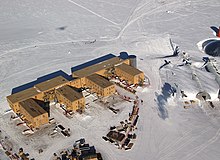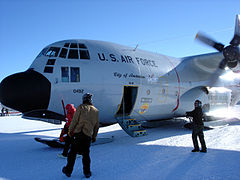Amundsen–Scott (polární stanice)
Polární stanice Amundsen–Scott (anglicky Amundsen–Scott South Pole Station) je americká výzkumná stanice umístěná 100 m od Jižního zemského pólu v Antarktidě. Nedaleko stanice se nachází takzvaný Ceremoniální Jižní pól, kde vlají vlajky několika států spolupracujících na stanici a také speciální plaketa.[1]
Pojmenována byla na počest Roalda Amundsena (jako první stanul v roce 1911 na jižním pólu) a jeho velkého soupeře Roberta F. Scotta (stanul na jižním pólu 17. ledna 1912 a na zpáteční cestě zahynul).
Speciální tradicí na stanici je pak 300 Club, jehož členové museli absolvovat nejdříve pobyt v sauně rozehřáté na teplotu 200 °F a poté vyjít ven do teploty nejvýše −100 °F.[1]
Budování stanice
Byla vybudována osmnáctičlennou skupinou z amerického námořnictva v listopadu 1956, od té doby byla permanentně obývána a udržována. V roce 1975 k ní přibyl Geodetický dóm – stavba ve tvaru kulového vrchlíku, 16 metrů vysoká, 50 metrů v průměru, která se stala hlavní budovou stanice a ke které byly roku 2003 přistavěny nové budovy vyvýšené stanice (Elevated station).
Fungování stanice

V létě počet obyvatel stanice typicky převyšuje 200, přes zimu zůstává 80–90 lidí. Stanice je zcela soběstačná, energii dodávají tři elektrické generátory, poháněné motorem na kerosin.
Dopravní spojení
Po stavbě geodetického dómu bylo zahájeno mezi stanicí a ostatním světem letecké spojení, kvůli čemu byla upravena 3 658 m dlouhá přistávací dráha. Letecké spojení na Amundsen–Scott je zajištěno přes další stanici, McMurdo, která má pravidelná letecká spojení s Novým Zélandem.
Výzkum
Výzkumná činnost stanice zahrnuje následující vědní obory:
Galerie
- Pohled na Elevated station z jižního pólu.
- Vstup do Geodetického domu demontovaného v roce 2010.
- Stanice za polární noci. Uprostřed je elektrárna, vpravo dole garáž a dílna pro mechaniky.
- Dodávka surovin a jídla z upraveného LC-130 Hercules.
- Uvnitř Geodetického dómu.
- Demontovaný Geodetický dóm z jižního pólu.
- Větší detail Elevated station.
Odkazy
Reference
V tomto článku byl použit překlad textu z článku Amundsen-Scott South Pole Station na anglické Wikipedii.
- ↑ a b Naked Scientists Race Around This South Pole Marker Every Winter. Atlas Obscura [online]. [cit. 2024-01-05]. Dostupné online. (anglicky)
Související články
- Klub 300
- Neutrinová observatoř IceCube
Externí odkazy
 Obrázky, zvuky či videa k tématu Polární stanice Amundsen–Scott na Wikimedia Commons
Obrázky, zvuky či videa k tématu Polární stanice Amundsen–Scott na Wikimedia Commons - Galerie obrázků ze stanice (i interiéru) od jednoho z jejích obyvatel
Média použitá na této stránce
Autor: Levent Demirörs, Licence: CC BY-SA 2.0
old Amundsen-Scott station under the dome
p1040175.jpg
Autor: Alexrk2, Licence: CC BY-SA 3.0
Location map Antarctica, Azimuthal equidistant projection
Polární stanice Amundsen-Scott během během polární noci. Uprostřed je elektrárna, vpravo dole garáž a dílna pro mechaniky. Na snímku je patrná polární záře.
Amundsen-Scott South Pole Station. The new elevated station nears completion. In the foreground is the ceremonial South Pole and the flags for the original 12 signatory nations to Antarctic Treaty.
Autor: Levent Demirörs, Licence: CC BY-SA 2.0
new Amundsen-Scott-Station left side details
p1030872.jpg
Buildings (Amundsen-Scott South Pole Station pictured) under construction. They have to be built on stilts at the South Pole to prevent snow buildup. The ceremonial pole and flags can be seen in the background, slightly to the left of center, below the tracks behind the buildings. The actual geographic pole is a few more metres to the left. Flags and pole are more visible in en:Image:Amundsen-scott-south pole station 2006.jpg and en:Image:Ceremonial South Pole.jpg.
The famous dome of Antarctica's Amundsen-Scott South Pole Station shimmers in the summer sunlight on Jan. 20, 1996. The flags of 13 nations which have officially adopted the Antarctic Treaty fly at the South Pole and represent the unprecedented international cooperation among the world community on the continent. This year 27 carefully selected workers and scientists will "winter over" by spending six months in total darkness in and around the station, sometimes braving temperatures which can fall to minus 100 degrees Fahrenheit, not including wind chill. Between October and February, the remote site at "the ends of the Earth" is reached by LC-130 Hercules ski-equipped aircraft flown by specially trained U.S. Navy and Air National Guard flight crews.
Autor: Původně soubor načetl JHG na projektu Wikipedie v jazyce angličtina, Licence: CC BY-SA 3.0
South Pole cargo crew unloading airplane passengers. This photo is 2004 (C) Zachary Staniszewski and it is released under the terms of GNU FDL.
















